Dining with Cajuns and Creoles
The foods of New Orleans are an expression of south Louisiana’s history, culture, and wetlands. Influences upon the area’s traditional cuisine are much like using recipes gathered at a crossroads of European, Caribbean, and Acadian culinary customs at interplay with local ideas and available ingredients. Understanding menus means knowing terms like — roux, remoulade, and bisque. Trying to suggest where to eat to visitors is as challenging as trying to suggest what to eat, just too much diversity. But understanding the culture and tastes behind the foods is a great way to start.
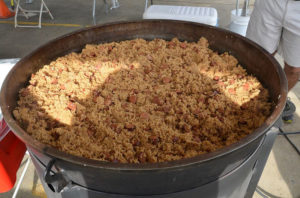
The distinction between Cajun and Creole foods can be confusing, overlapping, and misleading. Both are descended from European ancestry, yet the outcome on the plate may be less than distinct. Creoles trace to European aristocrats encouraged by the Spanish to establish New Orleans in the late 17th century. French, German, and Italian settlers also arrived and with them came terminologies, precepts, sauces, and cooking traditions. From the Provence of France came bouillabaisse (a local soup), a dish reflected in the creation of gumbo; the Spanish paella was the forefather of Louisiana’s jambalaya (right) and dirty rice, Germans brought knowledge of charcuterie (charring meat) and established boucheries (butcher shops) which are the base for locally produced sausage used to flavor many traditional dishes. Italian arrivals brought Mediterranean spices and pastries, from the West Indies came piquant flavorings, slow cooking techniques, and exotic vegetables. Local Choctaw and Houmas Indians introduced corn dishes, filé powder from sassafras leaves, and bay leaves from the local laurel tree. Europeans arriving in the 17th and 18th centuries were coming with dietary baggage reflecting their own epicurean genealogy. New Orleans housewives, cooks, and chefs became increasingly frustrated with not being able to acquire their traditional ingredients, thus ingenuity and resourcefulness brought unique people and diverse cultures who were willing to share their cooking styles and experiment with local ingredients.
The evolution of Cajun food is tied to the diffusion of Acadians from southeast Canada. Their refugee history in rural south Louisiana gave rise to the use of wild game, seafood, and local products from the swamps, bayous, and woods. What emerged were boiled crawfish, soups, gumbos, jambalaya, turtle sauce piquante and stuffed vegetable dishes, often just a “one-pot meal.” Spices became the stock ingredient to gumbos and sausages; and onions, celery and bell pepper became the “Holy Trinity” of Cajun cuisine. Cooking brought fellowship and social bonding among the Catholic immigrants. Around the household kitchen these days, men and women are equally talented cooks. A sampling of truly NOLA cuisine tends to show the infusion of Creole and Cajun and how two rich cultures lie at the base of every New Orleans menu.
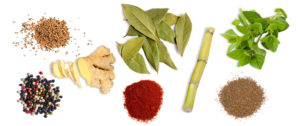 Flavorings. Nothing in a recipe can bring more debate than spices and yet there is no debate that it is spices that make the tastes of New Orleans an international cooking tradition. Chopped seasonings such as the Holy Trinity are at the beginning of many dishes, but perhaps the most known spice is Tabasco, a global term for hot sauce. Tabasco brand hot sauce is produced from Mexican peppers grown on Avery Island in south Louisiana. Avery Island is a geological salt dome rising above the coastal wetlands and has been the home of the McIlhenny family since the mid-1800s. Originally the peppers for McIlhenny’s hot sauce were grown on the island, but today the local peppers are used for seed stock and the peppers are grown from outside the United States. The sauce is still made on Avery Island. For many Louisianan’s, the meal is not set until the Tabasco is on the table. Another popular condiment locally produced is remoulade sauce. It reflects French-African Creole influence and is mayonnaise-based with green onions, celery, parsley, cayenne pepper, and paprika.
Flavorings. Nothing in a recipe can bring more debate than spices and yet there is no debate that it is spices that make the tastes of New Orleans an international cooking tradition. Chopped seasonings such as the Holy Trinity are at the beginning of many dishes, but perhaps the most known spice is Tabasco, a global term for hot sauce. Tabasco brand hot sauce is produced from Mexican peppers grown on Avery Island in south Louisiana. Avery Island is a geological salt dome rising above the coastal wetlands and has been the home of the McIlhenny family since the mid-1800s. Originally the peppers for McIlhenny’s hot sauce were grown on the island, but today the local peppers are used for seed stock and the peppers are grown from outside the United States. The sauce is still made on Avery Island. For many Louisianan’s, the meal is not set until the Tabasco is on the table. Another popular condiment locally produced is remoulade sauce. It reflects French-African Creole influence and is mayonnaise-based with green onions, celery, parsley, cayenne pepper, and paprika.
The Stock Pot. The tradition of one-pot meals prepared in a stock base is best enjoyed as a gumbo or etouffee or crawfish bisque. Every cook prides their roux, which is the base from which the liquid stock evolves. Rouxs are passed down through generations and can determine the outcome of the dish before any ingredients are ever added. The roux is a mix of oil or bacon fat (Cajuns may swear by butter instead which presents a blonde roux), with flour and cooked to a desired brownness. Gumbos are commonly seafood based with shrimp, crab meat, and oysters. Filé is added along with the Holy Trinity and okra. Chicken with pork sausage or andouille is another popular gumbo. Andouille originated in France and is claimed to have arrived with Cajun culture. Its popularity has seen generations of regional influence, especially from German immigrants along the German Coast of the lower Mississippi River. It is a smoked sausage using pork, garlic, pepper, onions, and seasonings encased in an intestinal sleeve.
Etouffee, from the French meaning to smother, is a dish cooked in a roux base with the lid on and again heavily spiced with onions, garlic, and peppers. As a testament to the continued evolution of new dishes in the south Louisiana tradition, it is said that etouffee originated in the 1950s among Cajuns along the Atchafalaya River and made its way to being one of the most popular dishes in New Orleans after it was added to the menu at Galatoire’s restaurant on Bourbon Street. Crawfish bisque is normally made in May or June, towards the end of the crawfish season. It is labor intensive and usually brings an entire family together to help prepare the dish. Preparation requires large quantities of peeled crawfish trails and the crawfish’s head (carapace) into which the ground tail meat is blended with seasonings and bread and then stuffed back into the crawfish head. It is served with a roux and rice. You will find dishes from the stock pot commonly served with rice and south Louisianian’s know that if it is Monday, it is red beans and rice. Among the Cajun and Creole households, Sunday’s meal would likely include a main dish of pork served with bone-in. Monday’s were wash days, thus cooking a pot of red beans with leftover pork bones and local sausage made for a one pot meal that simmered all day while attending to the wash. The tradition of red beans and rice continues and many small restaurants will only prepare and serve the dish on Mondays.
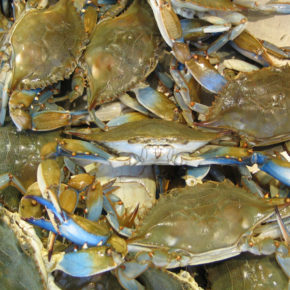
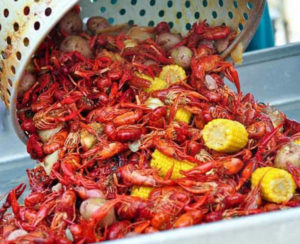 From the Wetlands and Gulf. South Louisiana is America’s largest coastal wetland. Brackish and freshwater lowlands extend along the state’s entire southern interface with the nutrient rich near shore waters of the Gulf of Mexico. The Atchafalaya River basin extends the freshwater wetlands northward. South Louisiana is rich in inshore fish, oysters, shrimp, blue crab (left), water fowl of many kinds, and alligators. It’s no wonder the state is called “Sportsman’s Paradise.” Cajun cooking uses all of these wild food sources, including alligator tail. Spring is crawfish season and the smell of backyard crawfish boils (right) emerges from every neighborhood. Our time in New Orleans will be at the peak of the season. Boiled crawfish are served by the pound and traditionally boiled in a blend of ginger, oregano, celery, cayenne, mustard seeds, peppercorns, bay leaves, and pickling spices along with whole potatoes, corn-on-the-cob, and sometimes slices of pork sausage are added to the pot. The aroma of a crawfish boil is intoxicating.
From the Wetlands and Gulf. South Louisiana is America’s largest coastal wetland. Brackish and freshwater lowlands extend along the state’s entire southern interface with the nutrient rich near shore waters of the Gulf of Mexico. The Atchafalaya River basin extends the freshwater wetlands northward. South Louisiana is rich in inshore fish, oysters, shrimp, blue crab (left), water fowl of many kinds, and alligators. It’s no wonder the state is called “Sportsman’s Paradise.” Cajun cooking uses all of these wild food sources, including alligator tail. Spring is crawfish season and the smell of backyard crawfish boils (right) emerges from every neighborhood. Our time in New Orleans will be at the peak of the season. Boiled crawfish are served by the pound and traditionally boiled in a blend of ginger, oregano, celery, cayenne, mustard seeds, peppercorns, bay leaves, and pickling spices along with whole potatoes, corn-on-the-cob, and sometimes slices of pork sausage are added to the pot. The aroma of a crawfish boil is intoxicating.
Fresh fish in south Louisiana means fresh that day! Eating the catch of the day provides diners with the opportunity to experience some of the more popular gulf catches prepared using about every Creole and Cajun touch imaginable. Gulf shrimp and blue crabs are the stock of many gumbos, seafood boils, fried platters, Poboys, etoufees, and rice dishes. Creole chefs have made these crustaceans a part of an endless variety of dishes. Restaurants across the city pride themselves in extending the diversity of preparing seafood. In many areas of south Louisiana, fried alligator tail is served on local menus. Its popularity has grown to where some fried chicken fast food eateries occasionally add it to their menu.
New Orleans has made oysters on the half-shell a crafted specialty. Either served raw or typically prepared with parsley, butter, Parmesan, and assorted herbs and then grilled or broiled. The uniqueness of the dish comes from the variations in preparation. Oysters Rockefeller was created in 1899 at Antoine’s and named after John D. Rockefeller, the richest American at the time; and Oysters Bienville, commonly thought to have originated at Arnaud’s, is now served at select restaurants. Oysters and other foods from the wetlands are what New Orleans cuisine is known for – the blend of Cajun’s dependence upon local food sources with Creole culinary preparation.
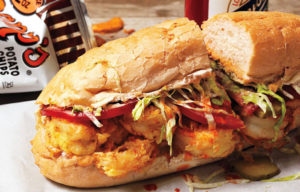
It’s not just a sandwich. The New Orleans PoBoy (right) is not a sub, its not a grinder or hoagie, and its not just a sandwich, it is a PoBoy. Beyond the grand restaurants of New Orleans, a more common and popular meal is the PoBoy, a meat sandwich served on French bread. PoBoys can be fried shrimp or oysters (corn meal batter), sausage, or a variety of fillings, but the best may be a chopped roast beef PoBoy served sloppy with gravy. The more napkins the better the quality. They can be served ‘dressed’ or not; dressed refers to with lettuce, tomato, and pickle. The term dressed seems to be limited to south Louisiana and it is always used when ordering a burger or PoBoy. Not all French breads make a good PoBoy. Leidenheimer Bakery (of direct German descent, founded in 1896) is hands down the most popular and each morning the skilled eye can spot hundreds of freshly baked loaves outside the delivery doors of restaurants serving traditional PoBoys. The history of the name PoBoy has about as many versions as there are types of PoBoys, but it is not disputed that fried oyster sandwiches on French loaves dates to the late 1800s.
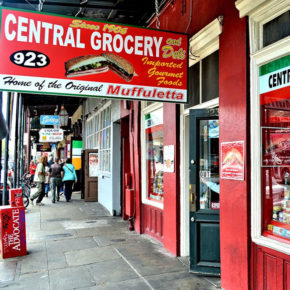
The muffuletta, another NOLA original, was first crafted at Central Grocery (left) on Decatur Street and theirs remains the most popular in town. Muffulettas are large round loaves stuffed with Italian ham and salami, a variety of cheeses, olive salad, lots of garlic, and then spiced. Leidenheimer Bakery produces a loaf many restaurants prefer. To have a traditional New Orleans “sandwich” is to enjoy the fusion of French, German, and Italian immigrants making foods for the working class of the 1800s.
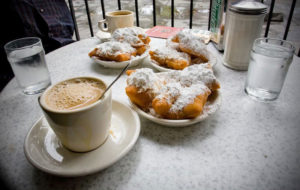
Caffeine and Cocktails. Dining is a major economy for south Louisiana and in New Orleans the top spot goes to the Café du Monde (Cafe of the World) in the heart of the French Quarter. Their fare is simple, but the lines are long. It is a landmark destination known for its café au lait (coffee and chicory with cream) and beignets (right). The French brought coffee with them as they settled the coast and in New Orleans, the Creoles added chicory (as there was often a shortage of coffee beans). Ground chicory root adds a chocolate-like flavor to coffee and had been used in 19th century European coffee houses. Adding cream became a way to soften the bitter taste. Beignets (a fried pastry) were part of Cajun cuisine carried from Europe to Acadia to South Louisiana. They are fried dough served hot and with powdered sugar on top. Coffee and beignets became a common breakfast food for all classes in New Orleans and today its popularity is impressive — a tourist trip to New Orleans is considered not complete without a stop at the Café du Monde (below left) for these sugary sweets.
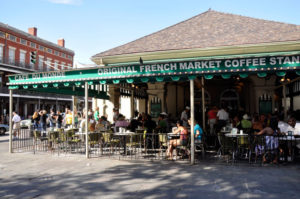
The local cocktail menu reflects creations unique to the city. Dixie beer, founded in 1907 has remained a local brew although the craft beer scene is thriving in NOLA. The rum-based Hurricane at Pat O’Brien’s and the Hand Grenade at The Tropical Isle are iconic French Quarter drinks and frozen daiquiris are sold along the sidewalks. But it is a Sazerac that the Louisiana Legislature proclaims as the official cocktail of New Orleans. The drink was created in the mid-1800s by Antoine Amedee Peychaud, a creole immigrant, who in his Vieux Carré pharmacy produced a Peychaud’s Bitters which is one ingredient in a Sazerac. Other ingredients include rye (locally Sazerac brand) and absinthe. There is some claim it is the oldest known American cocktail; regardless, the Sazerac Bar in the historic Roosevelt Hotel is a legendary landmark in New Orleans and there are cocktail tours to historic bars of the Vieux Carré, all of whom view their Sazerac as the city’s best.
Deserts and Sugary Snacks. Sugarcane dominates the lowland agricultural landscape of south Louisiana. It is a perfect crop for the area’s hot, rainy climate and muddy fields. Cane sugar became a common confection and cooking with sugar has led to Cajuns and Creoles finding ways to sweeten their already rich diet. A local classic is Bananas Foster, a desert made from bananas, vanilla ice cream, and a sauce made from brown sugar, dark rum, and cinnamon. It was created in 1951 by the chef at Brennan’s (French Quarter) Restaurant who saw hundreds of bananas left to rot around the United Fruit Company docks on the river. Banana trade from Central America to New Orleans once had a prosperous connection; the spilled fruit was there for the taking.

New Orleans also claims the sno-ball as its own. The shaved ice snack is served with a flavored cane syrup. Originally the sno-ball was made from scraping course ice from large blocks, but in 1934 Ernest Hansen developed an ice-shaving machine that produces a very fine ice and their family operated Hansen’s Sno-Bliz is still operating on Tchoupitoulas Street. Get there early as the lines can be long; their most popular sno-ball is their seasonal bananas foster! New Orleans has made the Praline a signature confection, although it is an Old World French candy. They are crafted from melting cane sugar with butter, cream, and pecans. The Mardi-Gras King Cake (right) is associated with the Epiphany and Catholic pre-Lenten celebrations. In the week leading up to Lent, King Cakes abound in bakeries and grocery stores. Typically they are decorated to reflect the themes and colors of Mardi-Gras. Inside the cake is often a small plastic baby representing Baby Jesus. Whomever gets the slice with the baby has various privileges and obligations. Many offices will have a King Cake every day of the week prior to Mardi-Gras and whomever gets the Jesus has to bring the next day’s cake. New Orleans recently renamed its Triple A baseball team from the Pelicans to the New Orleans Baby Cakes. Such is the recognition of Catholicism and celebratory cakes upon local culture.
Understanding how Louisianans eat, is understanding that the ancestry of the foods south Louisiana calls home is a result of culture tied to wetlands. The futures of both are endangered by south Louisiana losing about 16 square miles of coast each year. Subsidence and erosion account for the majority of the loss. The explanations behind both are tied to oil and gas extraction, attempts to control the Mississippi River, and building New Orleans in a most unnatural location. Contributors also include sea-level rise and the frequency of Hurricane landfalls, which erode away the shallow coastal edge. The threats to Louisiana have been measured and the losses mapped; the unintended consequence may also be the impact upon its food culture and traditions. Cajun ancestry is threatened by land loss as some of their communities have already been abandoned. Storms push others to seek new residence away from their lowland homelands. The loss of wetlands also means the loss of locally produced seafood.
A bucket-list for New Orleans always includes sampling great foods and historic restaurants. Whether morning, noon, or night — there is a food tradition that should serve every craving; the city is known for its bon appétit.
Clifton “Skeeter” Dixon is a professor of geography at the University of Southern Mississippi. He is a native to south Louisiana where he still resides for part of the year. Growing up, his family and community held a tradition of cooking and enjoying Creole and Cajun foods and thinks a backyard crawfish boil should be on everyone’s bucket list. Currently he is the past president of the Southeastern Division of the American Association of Geographers.


